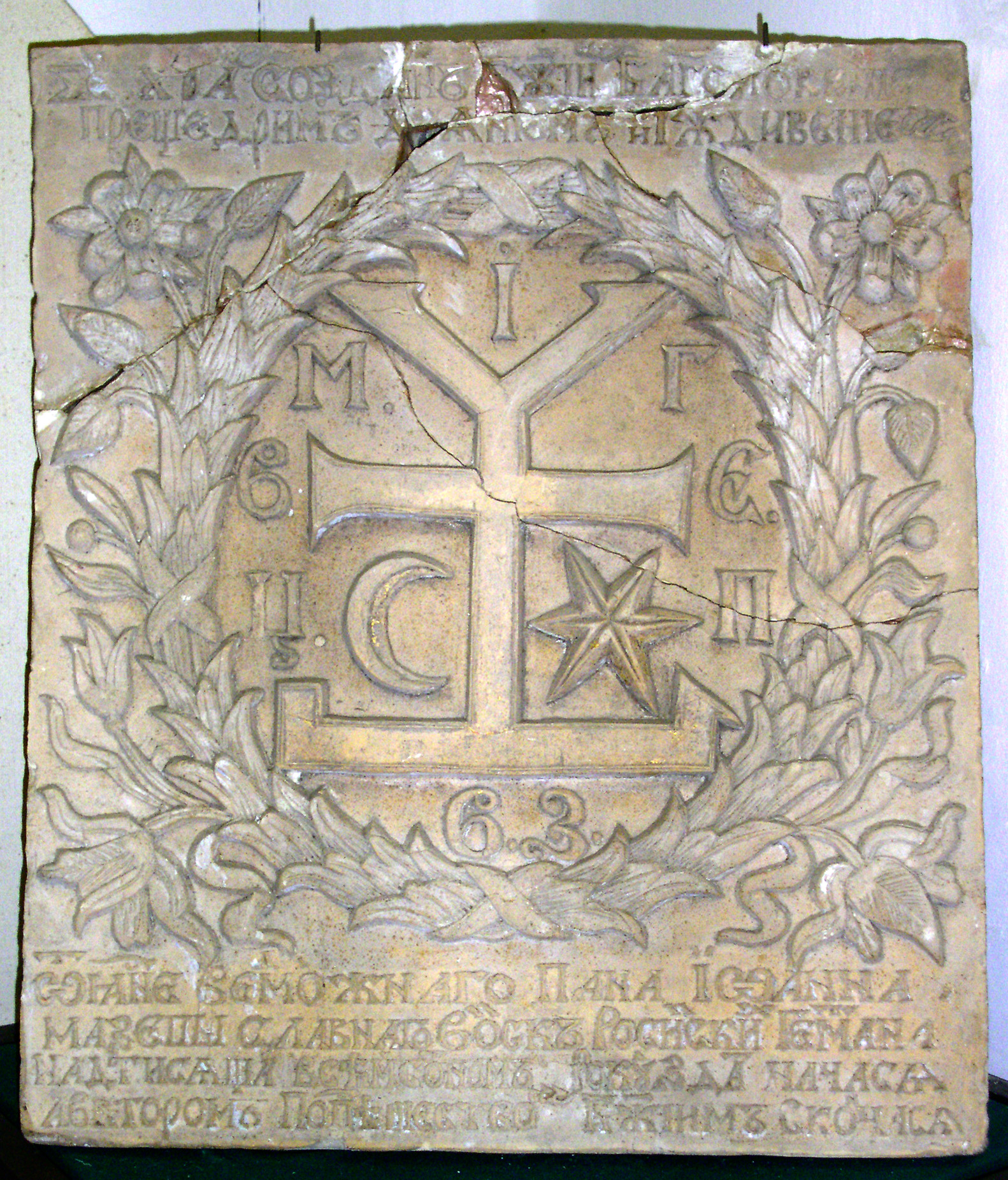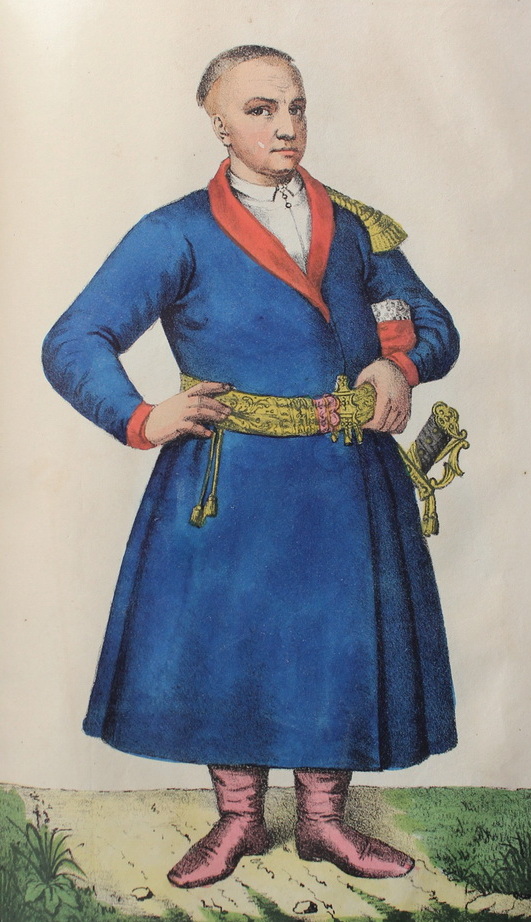|
Yesaul
Yesaul, osaul or osavul (, ) (from Turkic yasaul - ''chief''), is a post and a rank in the Russian and Ukrainian Cossack units. The first records of the rank imply that it was introduced by Stefan Batory, King of Poland in 1576. Cossacks in Russia There were different yesaul posts and ranks in Cossack Hosts in Imperial Russia: *Генеральный есаул (''generalny yesaul'') - General Yesaul *Походный есаул (''pokhodny yesaul'') - Campaign Yesaul *Войсковой есаул (''voiskovoy yesaul'') - Army Yesaul *Полковой есаул (''polkovoy yesaul'') - Regimental Yesaul *Артиллерийский есаул (''artilleriysky yesaul'') - Artillery Yesaul *Сотенный есаул (''sotenny yesaul'') - Company Yesaul (commander of a sotnia) *Станичный есаул (''stanichny yesaul'') - Yesaul of a stanitsa Cossack Hetmanate and Sloboda Ukraine In Ukraine of the 17th and 18th centuries, an osaul was a military and administrativ ... [...More Info...] [...Related Items...] OR: [Wikipedia] [Google] [Baidu] [Amazon] |
Military Ranks Of Russia
Modern Russian military ranks trace their roots to the Table of Ranks established by Peter the Great. Most of the rank names were borrowed from existing Germany, German/Prussian, France, French, England, English, Netherlands, Dutch, and Poland, Polish ranks upon the formation of the Russian regular army in the late 17th century. Russian Tsardom The Kievan Rus had no standing army apart from small ''druzhina'' (), a permanent group of personal guards for the local knyaz (); an individual member of such a unit called a ''druzhinnik'' (). In times of war, the ''knyaz'' raised a militia comprising volunteers from the peasantry, and the ''druzhina'' served as the core of the troops. Each local knyaz served as the military leader of his troops. Such arrangements did not need permanent ranks or positions; they were created ''ad hoc'', based on the task(s) at hand. Upon the formation of ''Streltsy, Strelets troops'' in the mid-16th century, the low-level commanding officers were appoi ... [...More Info...] [...Related Items...] OR: [Wikipedia] [Google] [Baidu] [Amazon] |
Cossack
The Cossacks are a predominantly East Slavic Eastern Christian people originating in the Pontic–Caspian steppe of eastern Ukraine and southern Russia. Cossacks played an important role in defending the southern borders of Ukraine and Russia, countering the Crimean-Nogai raids, alongside economically developing steppe regions north of the Black Sea and around the Azov Sea. Historically, they were a semi-nomadic and semi-militarized people, who, while under the nominal suzerainty of various Eastern European states at the time, were allowed a great degree of self-governance in exchange for military service. Although numerous linguistic and religious groups came together to form the Cossacks, most of them coalesced and became East Slavic–speaking Orthodox Christians. The rulers of the Polish–Lithuanian Commonwealth and Russian Empire endowed Cossacks with certain special privileges in return for the military duty to serve in the irregular troops: Zaporozhian Cossac ... [...More Info...] [...Related Items...] OR: [Wikipedia] [Google] [Baidu] [Amazon] |
Ivan Mazepa
Ivan Stepanovych Mazepa (; ; ) was the Hetman of the Zaporozhian Host and the Left-bank Ukraine in 1687–1708. The historical events of Mazepa's life have inspired Cultural legacy of Mazeppa, many literary, artistic and musical works. He was famous as a patron of the arts. Mazepa played an important role in the Battle of Poltava (1709), where after learning that Tsar Peter the Great, Peter I intended to relieve him as acting hetman of Cossack Hetmanate, Zaporozhian Host and to replace him with Alexander Danilovich Menshikov, Alexander Menshikov, he Defection, defected from his army and sided with King Charles XII of Sweden. The political consequences and interpretation of this defection have resonated in the national histories both of Russia and of Ukraine. The Russian Orthodox Church laid an anathema (excommunication) on Mazepa's name in 1708 and still refuses to revoke it. The anathema was not recognized by the Ecumenical Patriarchate of Constantinople, which considers it C ... [...More Info...] [...Related Items...] OR: [Wikipedia] [Google] [Baidu] [Amazon] |
Military Organization Of Cossacks
A military, also known collectively as armed forces, is a heavily armed, highly organized force primarily intended for warfare. Militaries are typically authorized and maintained by a sovereign state, with their members identifiable by a distinct military uniform. They may consist of one or more military branches such as an army, navy, air force, space force, marines, or coast guard. The main task of a military is usually defined as defence of their state and its interests against external armed threats. In broad usage, the terms "armed forces" and "military" are often synonymous, although in technical usage a distinction is sometimes made in which a country's armed forces may include other paramilitary forces such as armed police. Beyond warfare, the military may be employed in additional sanctioned and non-sanctioned functions within the state, including internal security threats, crowd control, promotion of political agendas, emergency services and reconstruction, pro ... [...More Info...] [...Related Items...] OR: [Wikipedia] [Google] [Baidu] [Amazon] |
Serfdom
Serfdom was the status of many peasants under feudalism, specifically relating to manorialism and similar systems. It was a condition of debt bondage and indentured servitude with similarities to and differences from slavery. It developed during late antiquity and the Early Middle Ages in Europe and lasted in some countries until the mid-19th century. Unlike slaves, serfs could not be bought, sold, or traded individually, though they could, depending on the area, be sold together with land. Actual slaves, such as the kholops in Russia, could, by contrast, be traded like regular slaves, abused with no rights over their own bodies, could not leave the land they were bound to, and marry only with their lord's permission. Serfs who occupied a plot of land were required to work for the lord of the manor who owned that land. In return, they were entitled to protection, justice, and the right to cultivate certain fields within the manor to maintain their own subsistence. Serfs wer ... [...More Info...] [...Related Items...] OR: [Wikipedia] [Google] [Baidu] [Amazon] |
Sotnik
Sotnik or sotnyk (; ; ) was a military rank among the Cossack starshyna (military officers), the Russian ''streltsy'' and Cossack cavalry, the Ukrainian Insurgent Army, the Ukrainian Galician Army, and the Ukrainian People's Army. Administrative rank Holders of the rank also served as leaders of territorial units. In the Cossacks' paramilitary society of the Zaporozhian Host, Cossack Hetmanate, and Sloboda Ukraine, territories were organized along the lines of military organization and commanded by officers. During the Khmelnytsky Uprising and in the Cossack Hetmanate (17th-18th centuries), ''sotnyks'' were leaders of territorial administrative subdivisions called ''sotnyas''. Such sotnyks were subordinated to ''polkovnyks'' (colonel) who were in control of a polk (primary administrative division) and a regiment (military unit). Military ranks The word ''sotnik'' literally means ''commander of a hundred men'' in most Slavonic languages, much like how the Latin term Centurion r ... [...More Info...] [...Related Items...] OR: [Wikipedia] [Google] [Baidu] [Amazon] |
Infantry
Infantry, or infantryman are a type of soldier who specialize in ground combat, typically fighting dismounted. Historically the term was used to describe foot soldiers, i.e. those who march and fight on foot. In modern usage, the term broadly encompasses a wide variety of subspecialties, including light infantry, irregular infantry, heavy infantry, mountain infantry, motorized infantry, mechanized infantry, Airborne forces, airborne infantry, Air assault, air assault infantry, and Marines, naval infantry. Other subtypes of infantry, such as line infantry and mounted infantry, were once commonplace but fell out of favor in the 1800s with the invention of more accurate and powerful weapons. Etymology and terminology In English, use of the term ''infantry'' began about the 1570s, describing soldiers who march and fight on foot. The word derives from Middle French , from older Italian (also Spanish) ''infanteria'' (foot soldiers too inexperienced for cavalry), from Latin '' ... [...More Info...] [...Related Items...] OR: [Wikipedia] [Google] [Baidu] [Amazon] |
Captain (OF-2)
The army rank of captain (from the French ) is a commissioned officer rank historically corresponding to the command of a company of soldiers. The rank is also used by some air forces and marine forces, but usually refers to a more senior officer. History The term ultimately goes back to Late Latin meaning "head of omething; in Middle English adopted as in the 14th century, from Old French . The military rank of captain was in use from the 1560s, referring to an officer who commands a company. The naval sense, an officer who commands a man-of-war, is somewhat earlier, from the 1550s, later extended in meaning to "master or commander of any kind of vessel". A captain in the period prior to the professionalization of the armed services of European nations subsequent to the French Revolution, during the early modern period, was a nobleman who purchased the right to head a company from the previous holder of that right. He would in turn receive money from another nobleman t ... [...More Info...] [...Related Items...] OR: [Wikipedia] [Google] [Baidu] [Amazon] |
Cavalry
Historically, cavalry (from the French word ''cavalerie'', itself derived from ''cheval'' meaning "horse") are groups of soldiers or warriors who Horses in warfare, fight mounted on horseback. Until the 20th century, cavalry were the most mobile of the combat arms, operating as light cavalry in the roles of reconnaissance, Screening (tactical), screening, and skirmisher, skirmishing, or as heavy cavalry for decisive economy of force and shock attacks. An individual soldier in the cavalry is known by a number of designations depending on era and tactics, such as a cavalryman, Equestrianism, horseman, trooper (rank), trooper, cataphract, knight, Drabant Corps of Charles XII, drabant, hussar, uhlan, mamluk, cuirassier, lancer, dragoon, samurai or horse archer. The designation of ''cavalry'' was not usually given to any Military animal, military forces that used other animals or platforms for mounts, such as chariots, Camel cavalry, camels or War elephant, elephants. Infantry who m ... [...More Info...] [...Related Items...] OR: [Wikipedia] [Google] [Baidu] [Amazon] |
Rittmeister
Rittmaster () is usually a commissioned officer military rank used in a few armies, usually equivalent to Captain. Historically it has been used in Germany, Austria-Hungary, Scandinavia, and some other countries. A is typically in charge of a squadron (a company-sized unit called a "troop" in the United States, as opposed to the U.S. cavalry squadron of larger battalion size), and is the equivalent of a ''Hauptmann'' rank (or captain in most army branches). Spelling * * * (until 1951) * (bokmål; the spelling ''ritmester'' was used until 1907) or ''rittmeister'' (nynorsk) * The armies of many Central and Eastern European countries adopted a localised term for the similar rank. * * * * * Czechia The rank of is an 'ensign' rank, used by both branches in the Czech Army. It is ranked OR-5 within the NATO rank structure. The immediate senior rank is called () and is ranked OR-6. The Netherlands The Dutch rank ''Ritmeester'', is the rank of squadron leading officers ... [...More Info...] [...Related Items...] OR: [Wikipedia] [Google] [Baidu] [Amazon] |



